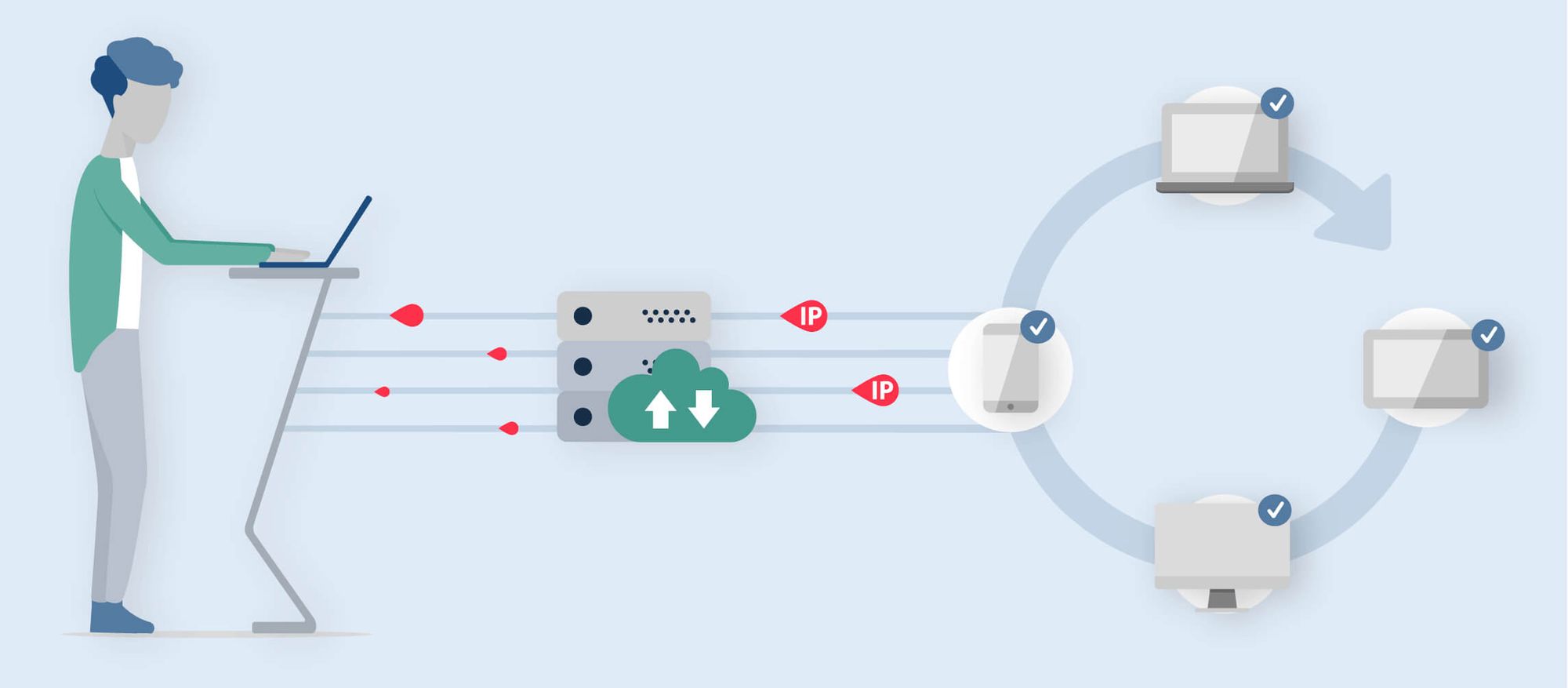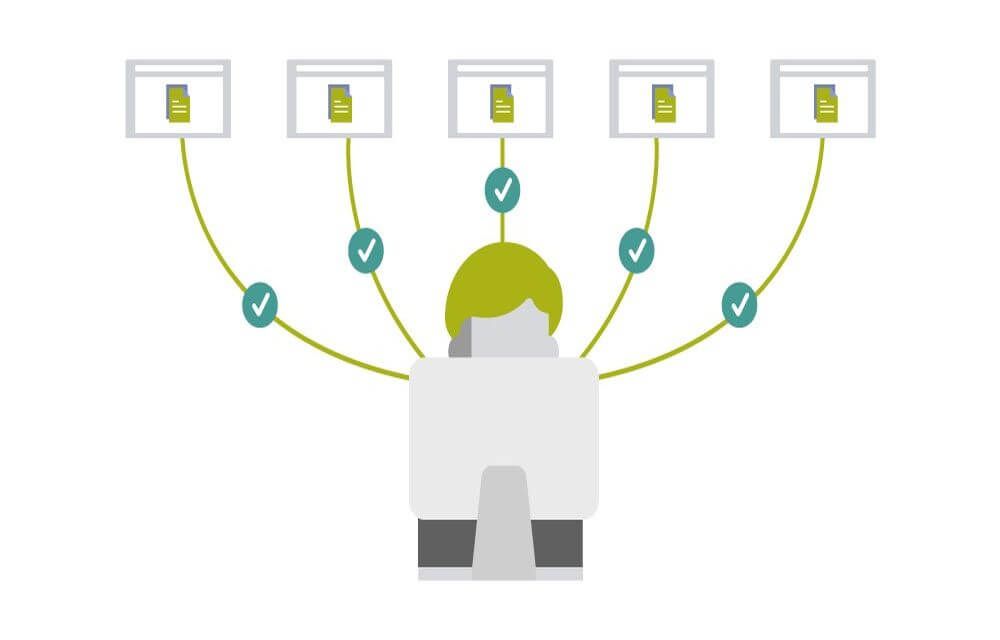What is a rotating proxy and how does it work?
Rotating IP proxy cyclically changes IP addresses from the proxy pool to make it harder for web servers to recognize them. This ensures that IP addresses are used evenly, which makes them less likely to be blocked on the target site's server.
If you don’t want your IP addresses to be suspicious, you should change it periodically. This step will allow you to access the target site from a different address, or even from a different location, depending on the capabilities of your proxy server with IP address rotation.
From the article, you will learn what proxy rotation is, why it is needed and what advantages this method has.

What is a rotating proxy?
Rotating IP proxies are proxies that cyclically change IP addresses from their pool to make it harder for web servers to identify the user. This ensures that IP addresses are used evenly, which makes them less likely to be blocked on the target site.
Rotary proxies are much better suited for complex web scraping tasks. Since the most popular websites use anti-tampering technologies that detect abnormal activity, especially sudden spikes in traffic from a single IP address, using proxies and real IP addresses helps avoid blocking and successfully retrieve the required data. Such proxy servers will make it seem as if several real users from different places are browsing the site at the same time, which guarantees you stealth and reliability in obtaining this data.
Why rotate proxies?
There are several reasons why rotate proxies. This will be useful for gaining benefits in different areas.
Using in social media marketing
Almost half of the population has a social media account, making social media marketing a powerful tool. A growing business must have a lot of customers to drive sales.
The competition on social media is very strong. Therefore, you need to use multiple accounts to publish posts and comments. However, such a method is against the rules of most platforms. Rotating proxies solves this problem by automatically changing the IP address and making the social platform's servers think the connection is coming from a different location.
Application in content restriction
IP addresses are limited geographically to some sites, although this is not widespread. There is an effective way to bypass this blockage. Selecting proxy servers with IP addresses outside of a geographic area in their pool bypasses geo-based blocking and allows access to these websites.
Whether you want to watch a movie or TV show, access a blog, or access geo-blocked content for any reason, the proxy rotation will help you.
Application in web scraping and crawling
Both scraping and crawling are actively used by various companies to detect trends in the industry and markets, as well as prepare for new challenges.
Websites have learned to identify crawling bots and block the IP address from which they connect. Rotating proxies are commonly used when parsing and crawling web pages. The idea is simple, bots and parser tools use different IP addresses to traverse the Internet; chances of getting banned from websites are minimal or absent.
Application in SEO
SEO is a vital process for many online companies, as is social media marketing. Keyword research, ranking tracking, technical optimization, and competitor analysis are all part of a good SEO strategy.
To audit a competitor, you need to crawl the website. Failure to perform such operations can lead to IP blocking. The solution is rotating IP proxy. A new IP address for each request ensures that the site audit is complete, no matter how many pages need to be removed and crawled.
What is IP address rotation and how does it work?
IP rotation is a process in which assigned IP addresses are distributed to a device at random or at scheduled intervals.
How do rotating proxies work?
For example, when a connection is active through an Internet Service Provider (IPP), the IP address is automatically attached from the pool of IP addresses. Once disconnected and reconnected, the ISP allocates the next available IP address, creating an IP rotation.
ISPs use IP address rotation because they usually have more users at their disposal than IP addresses. Hence, when a particular user disconnects, the ISP will return the user's last used IP address to their IP pool, thereby ensuring that existing resources are optimized.
Thus, ISPs change IP addresses and the process is transparent to their users. However, there’re many cases on the Internet where users intentionally change their IP addresses. If the proxy is fine-tuned, you can rotate the IP addresses from the proxy pool of IP addresses. With Rotary Proxies, you can manage multiple connections from a single device, making web crawling and data scraping operations much easier.
Common methods to rotate IP addresses
If you are interested in how to manage a proxy server with IP address rotation on your computer, we will assume that you already have a certain number of private proxy servers. To successfully rotate IP addresses manually, you need to do the following:
Choose reliable proxy servers
Not all proxies are created equal. Check the reliability and safety of each one before proceeding.
Divide Proxy servers into groups
Choose how many proxies will be used in each rotation. For example, if you have 100 reliable proxy servers, divide them into 10 groups of 10 IP addresses. The more proxy servers and groups there are, the more efficient site visits are.

Change groups
Over time, after too long use, addresses from your first group may begin to be recognized by servers as suspicious. To avoid this, simply switch to the next group of proxy servers and you can continue to visit the resources you are interested in.
Some many options and tools can be used as a homemade IP address rotator and one of them is the Python rotary proxy. Python is a programming language that can help you with many queries, including crawling sites and retrieving web data. In other words, if you don't want to raise suspicion when crawling sites and fetching data with a bot, you should consider using a Python rotary proxy.
Why waste time doing ip rotation manually? Litport provides automatic rotation. You save money on the engineers work: all actions are performed in one click.
Are rotating proxies the best?
Rotating IP is a great way to ensure anonymity on the Internet. This is especially true today when news about the disclosure of personal data of Internet users is heard more and more often. The use of rotary IP also helps to protect against hacker attacks and not be noticed on other resources.
Features and benefits of rotating proxies
The advantages of a rotating IP address are as follows:
- You don't need to manually adjust the settings. The use of a rotating IP makes the address of each device truly unique. This is a great solution to the problem when one device connected to Wi-Fi has internet, while others do not.
- No one will be able to track the activity of the device on the Internet. This applies to all aspects of using the Internet, including protection from the collection of personal data by advertising aggregators.
- It’s possible to visit any resources, even those that have blocked the access of a user with a specific IP.
- A user with a rotating IP can perform any actions on the Internet: access any resources without fear of getting an individual digital fingerprint. This’s very useful for some professions, for example, if a person is engaged in hidden PR.
- Rotating IP address allows you to have more clients. Since not all users connect to the Internet at the same time, when connecting, one of the IP addresses is selected, which is currently free and assigned to a computer with Internet access.
Conclusion
Using a rotating IP address is an opportunity to be a kind of chameleon, which is not easy to find on the Internet. It’s very valuable today. After all, more and more news appears that personal data has been leaked to the Internet. Rotating IP is also easier to set up and use.
You can order a rotary IP from Litport. We use our equipment and original software, thanks to which we provide high-quality services in the Americas, Europe, Asia, and Africa.